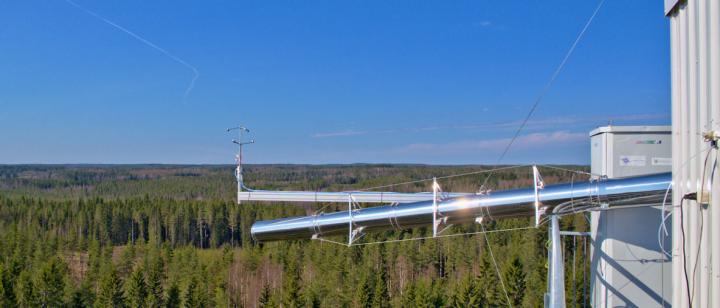We need one global network of 1000 stations to build an Earth observatory

SMEAR II is a station for measuring environmental data in Hyytiälä, Finland. Credit: Juho Aalto
Environmental challenges, climate change, water and food security and urban air pollution, they are all interlinked, yet each is studied as such, separately. This is not a sustainable situation, for anybody anymore. To tackle this, professor Markku Kulmala calls for a continuous, comprehensive monitoring of interactions between the planet's surface and atmosphere in his article published in Nature, January 4, 2018.
In his article “Build a global Earth observatory”, he refers to his long experience of collecting environmental data. He has built a station, and not just one, but probably the most impressive station, called SMEAR II (Station for Measuring Ecosystem-Atmosphere Relationships), in the boreal forests of Finland showing how a rounded set of environmental measurements can be obtained.
Now building on a large scale, the answer is a global Earth observatory, consisting of 1,000 or more well-equipped ground stations around the world that track environments and key ecosystems fully and continuously. Data from these stations would be linked to data from satellite-based remote sensing, laboratory experiments and computer models accordingly.
“Incomplete coverage from ground stations is the main limit to observations of Earth's conditions. Satellites can continuously, online 24/7, monitor some compounds, such as CO2, ozone and aerosols, almost planet-wide. But they cannot resolve processes or fluxes, or trace the hundreds more compounds of interest. Satellite data must be 'ground-truthed', professor Kulmala says.
This global observatory of 1,000 super stations needs to be established soon, within 10-15 years.
“The costs would be around €10 million (US$11.8 million) to €20 million per station, which can be compared to the building costs of the Large Hadron Collider at CERN, Geneva, Switzerland, or that of US President Donald Trump's proposed Mexican wall.”
Nevertheless, a shift in how environmental data are collected and disseminated is needed, there is no question about that.
“There is a scientific interest, as well, in this data,” professor Markku Kulmala says, “the researchers could find new mechanisms and feedback loops in this coherent data set.”
###
Markku Kulmala is a professor of physics and director of the Institute for Atmospheric and Earth System Research at the University of Helsinki, Finland; and head of the Aerosol and Haze Laboratory at the Beijing University of Chemical Technology, China.
Markku Kulmala, Build a global Earth Observatory, Nature, Vol. 553, 4 January 2018
Image: Juho Aalto, SMEAR II Station in Hyytiälä, Finland
Contact details: Markku Kulmala, + 358 40 596 2311, markku.kulmala@helsinki.fi
Kind regards, Press Officer Minna Meriläinen-Tenhu, +358 50 415 0316, @MinnaMeriTenhu, minna.merilainen@helsinki.fi
Media Contact
All latest news from the category: Earth Sciences
Earth Sciences (also referred to as Geosciences), which deals with basic issues surrounding our planet, plays a vital role in the area of energy and raw materials supply.
Earth Sciences comprises subjects such as geology, geography, geological informatics, paleontology, mineralogy, petrography, crystallography, geophysics, geodesy, glaciology, cartography, photogrammetry, meteorology and seismology, early-warning systems, earthquake research and polar research.
Newest articles

Why getting in touch with our ‘gerbil brain’ could help machines listen better
Macquarie University researchers have debunked a 75-year-old theory about how humans determine where sounds are coming from, and it could unlock the secret to creating a next generation of more…

Attosecond core-level spectroscopy reveals real-time molecular dynamics
Chemical reactions are complex mechanisms. Many different dynamical processes are involved, affecting both the electrons and the nucleus of the present atoms. Very often the strongly coupled electron and nuclear…

Free-forming organelles help plants adapt to climate change
Scientists uncover how plants “see” shades of light, temperature. Plants’ ability to sense light and temperature, and their ability to adapt to climate change, hinges on free-forming structures in their…





















